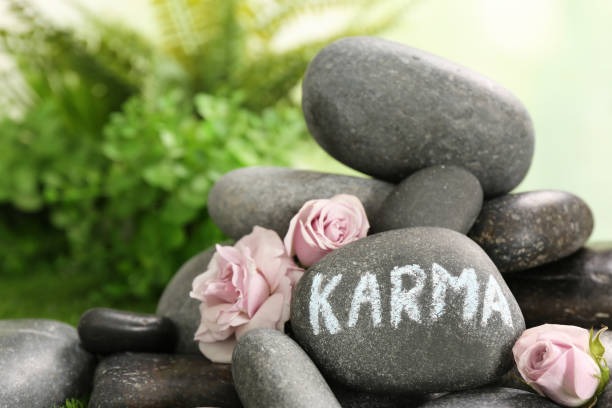
Karma & Dharma
The Universal Balance of Action, Purpose, and Soul Growth
Karma and Dharma are ancient spiritual concepts that describe how our actions shape our experience and how our soul aligns with its true path. Though often misunderstood in modern culture, their roots run deep through Hinduism, Buddhism, Jainism, and other Eastern philosophies. Together, they form a powerful framework for understanding personal growth, responsibility, and spiritual evolution.
Karma shows us how energy moves through action.
Dharma shows us why we are here, and how to live in alignment.
When both work together, life flows with clarity, integrity, and purpose.
Historical Origins
Karma
The concept of karma first appeared in the Vedic texts of ancient India (1500–500 BCE).
The Sanskrit word karma means “action,” but spiritually it also refers to the energetic consequences of thought, intention, and behavior.
In these traditions, karma is not punishment.
It is cause and effect, the natural return of whatever energy we put into the world.
Dharma
Dharma is an even older concept.
The Sanskrit word dharma translates to “duty,” “right action,” “law,” or “sacred purpose.”
Its teachings appear in Hinduism, Buddhism, Jainism, and Sikhism — slightly different in each but always pointing toward living in alignment with universal truth.
Where karma is about what you do,
Dharma is about who you are meant to be.
Understanding Karma — The Energy of Action
Karma is the energetic imprint left behind by our choices.
Positive (Constructive) Karma
Created through:
Kindness
Integrity
Compassion
Generosity
Truthfulness
Acting from love instead of fear
This energy returns to you as peace, opportunities, harmony, or growth.
Negative (Destructive) Karma
Created through:
Harmful intent
Manipulation
Dishonesty
Jealousy or cruelty
Exploiting others
Acting from ego or woundedness
This energy eventually returns as challenges that push you to learn, correct, or evolve.
Karma is not punishment from the universe —
it’s feedback that guides the soul toward balance.
Ancestral & Past-Life Karma
Many spiritual traditions teach that karma can extend beyond a single lifetime.
Ancestral Karma
Patterns, beliefs, or emotional wounds passed down through generations:
Scarcity mindsets
Trauma
Addictive behaviors
Cultural or family burdens
Healing ancestral karma brings liberation not only to you but to your lineage.
Past-Life Karma
Unresolved lessons or soul contracts from previous incarnations
may surface as:
Repetitive relationship dynamics
Unexplained fears
Strong talents
Instant sense of connection or repulsion
Feeling “called” to certain places or people
Clearing these patterns brings clarity, ease, and deeper self-understanding.
How to Clear Negative Karma
You cannot erase karma — but you can transform it.
1. Awareness & Accountability
Recognizing your patterns is the first step.
Ask: What am I repeating, attracting, or avoiding?
2. Forgiveness
Forgive yourself, others, and the situation.
Forgiveness cuts the energetic thread.
3. Right Action
Make conscious choices moving forward.
Do good because it feels aligned — not because of fear.
4. Service & Kindness
Helping others generates powerful healing energy.
This is known as seva in Hindu philosophy.
5. Ritual or Energetic Clearing
Meditation, ancestral healing, cord-cutting, and shadow work
help release karmic residue.
6. Break the Cycle
Change the behavior that created the pattern.
The moment you choose differently, the karmic loop dissolves.
Understanding Dharma — Your Sacred Purpose
Dharma is the spiritual path your soul chose for this lifetime.
It is:
Your gifts
Your passions
Your responsibilities
Your lessons
Your soul’s natural direction
Everyone has unique dharma — and multiple layers of it.
Types of Dharma
1. Universal Dharma
The shared responsibility of all humans:
Be truthful
Be kind
Cause no harm
Seek growth
Live with integrity
2. Personal Dharma
Your individual life purpose:
Your soul gifts
Your talents
Your unique role in the world
3. Stage-of-Life Dharma
The duties appropriate to a certain phase of life:
Student
Parent
Leader
Elder
Healer
Artist
Dharma shifts as you grow.
How to Discover Your Dharma
Clues include:
What you naturally excel at
What brings you joy
What others come to you for
What feels meaningful
What you can’t stop thinking about
What feels like “home” to your soul
Your dharma is where your abilities, your passions, and your desire to help the world intersect.
How to Live Your Dharma Daily
Make choices rooted in authenticity
Follow your intuition
Listen to what lights you up
Let go of roles that no longer fit
Allow your purpose to evolve
Practice mindfulness, meditation, or prayer
Serve where you feel called
When you walk in your dharma, the universe rearranges itself to support you.
Karma + Dharma Working Together
Karma is the energy you create.
Dharma is the path you walk.
Karma shapes the lessons you meet.
Dharma shapes how you move through them.
Living your dharma naturally generates good karma.
Healing your karma clears the path for authentic dharma.
Together, they create a life of:
Alignment
Meaning
Harmony
Spiritual growth
Soul fulfillment
Karma and Dharma remind us that we are powerful creators of our own lives. Every thought, word, action, and intention shapes the energy we walk with — and influences the experiences that return to us. When we act with compassion, honesty, and purpose, we naturally heal the past and walk into a brighter, clearer future.
Living in alignment with your dharma brings peace.
Acting with conscious karma brings balance.
Together, they teach us how to live with integrity, kindness, and soul-centered awareness.
The simplest reminder is the golden rule - do unto others as you would have done unto you.


